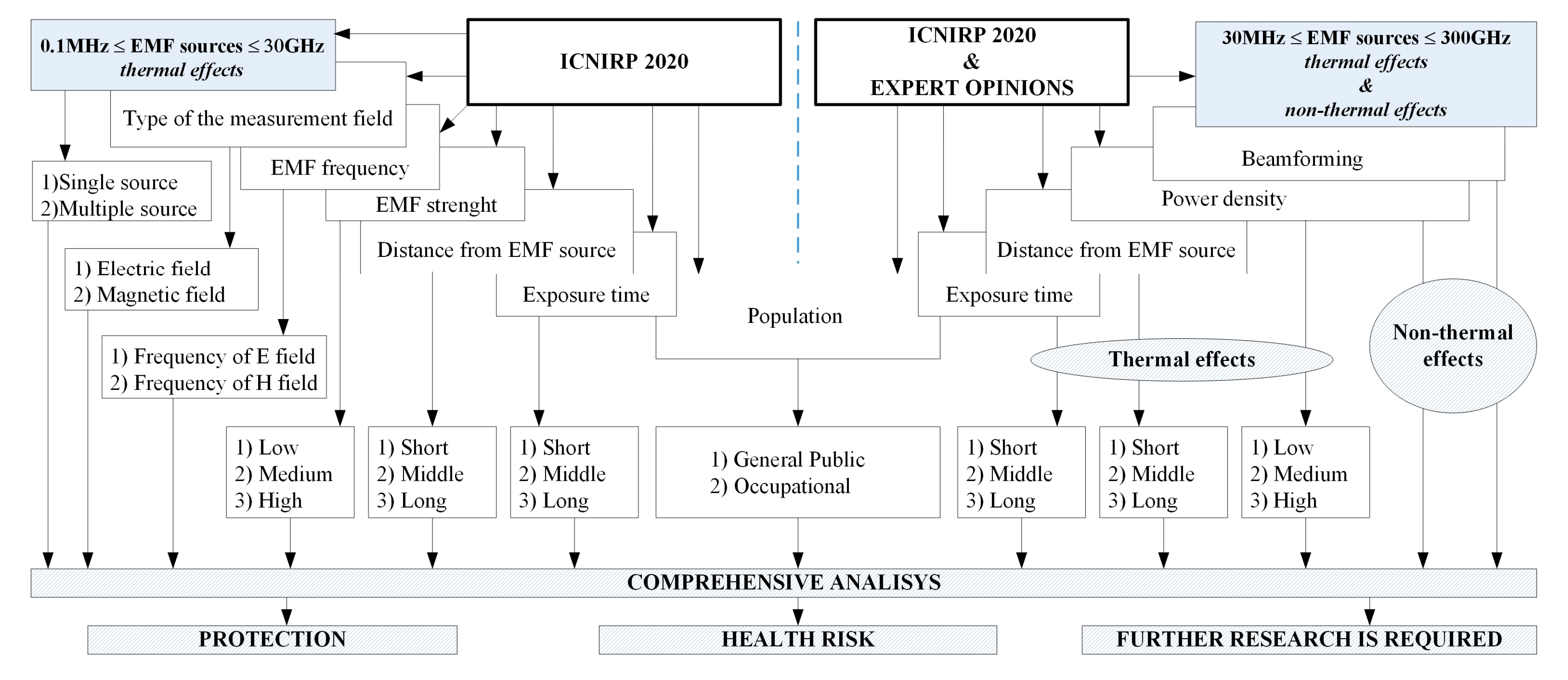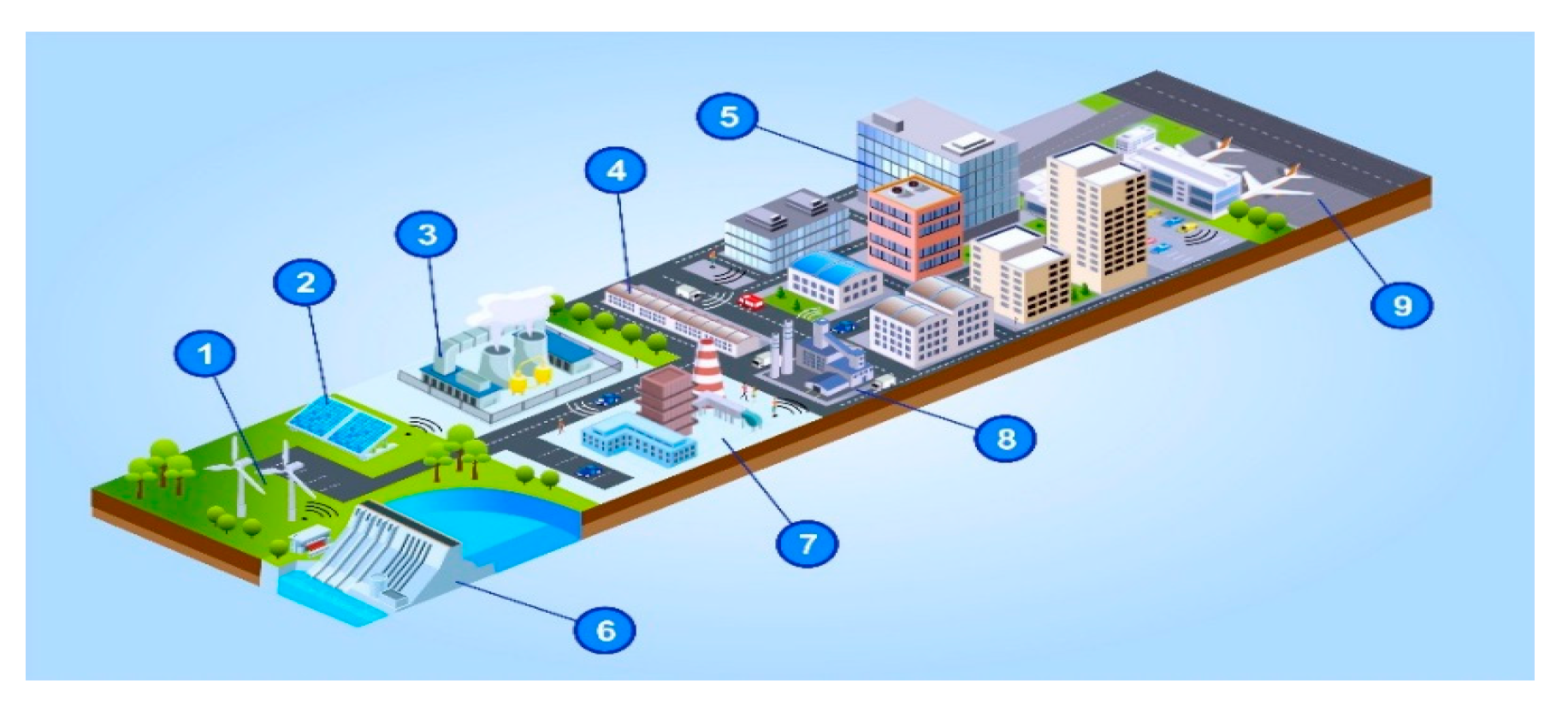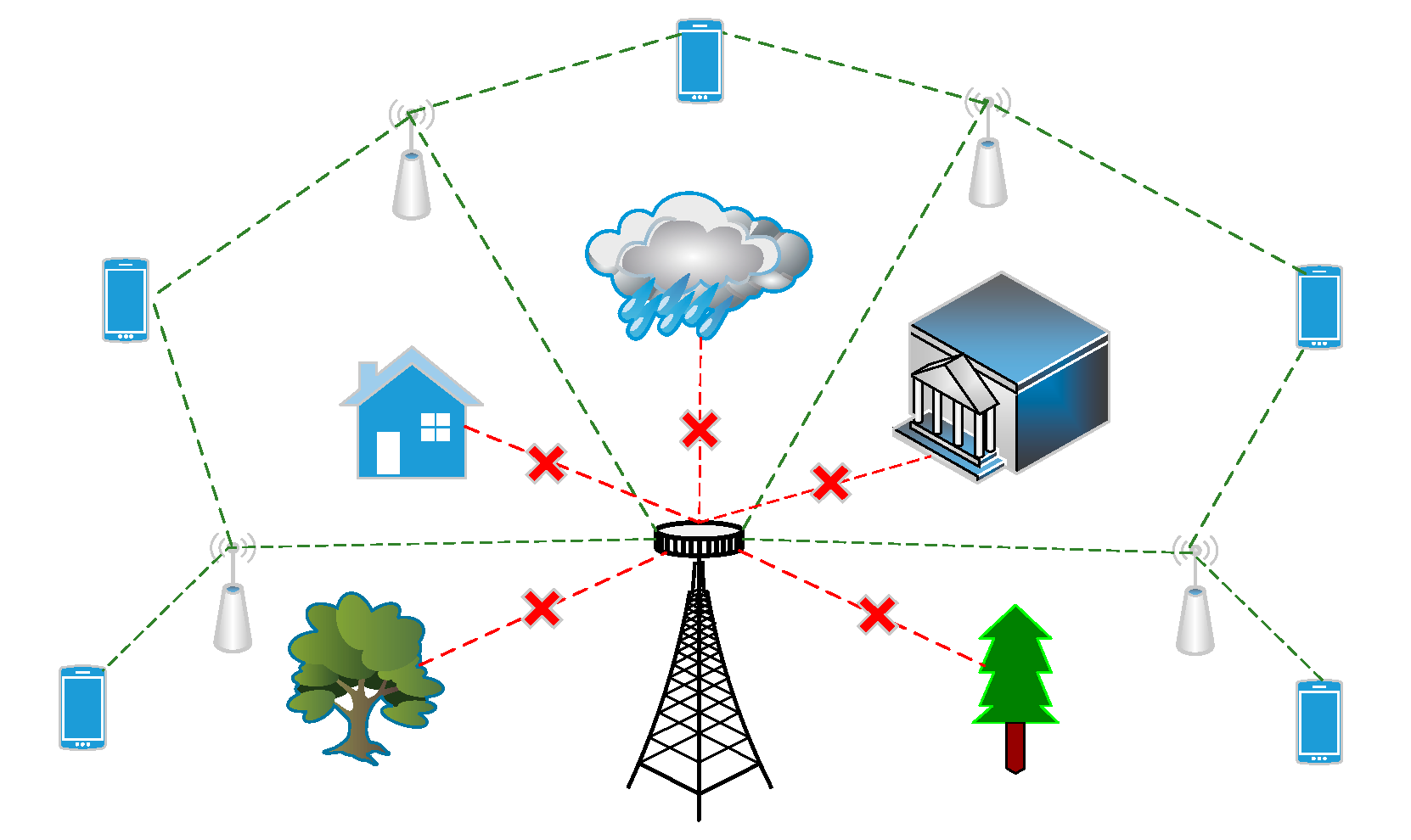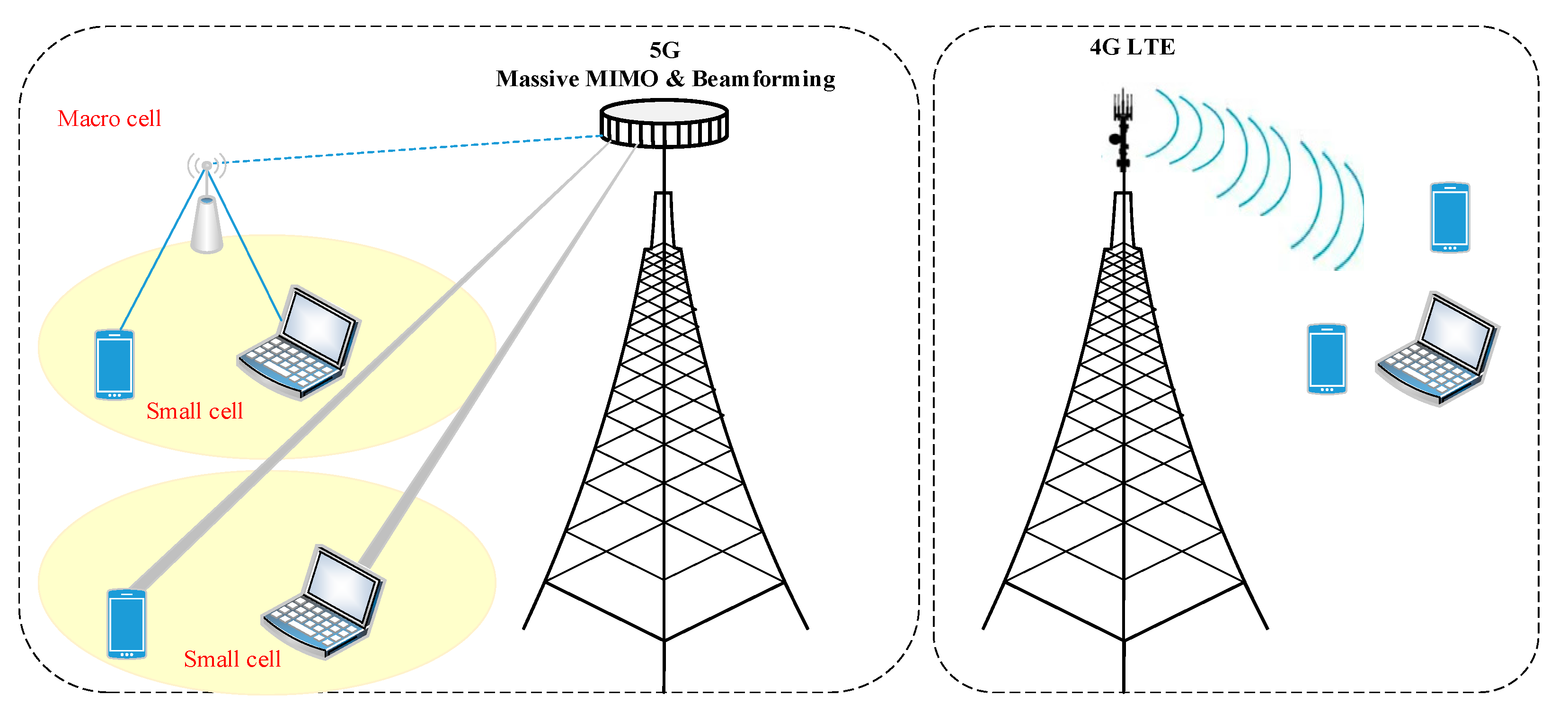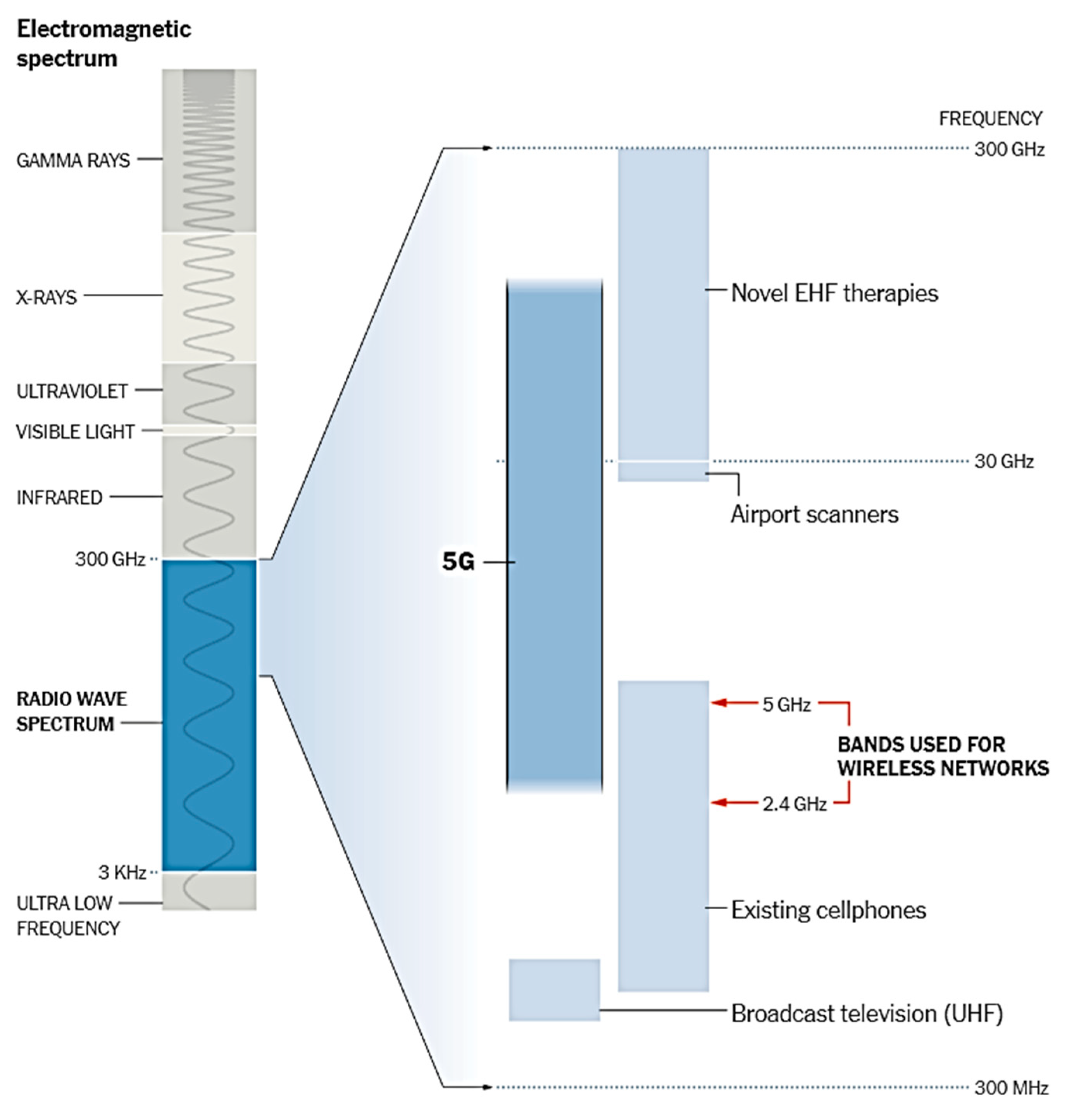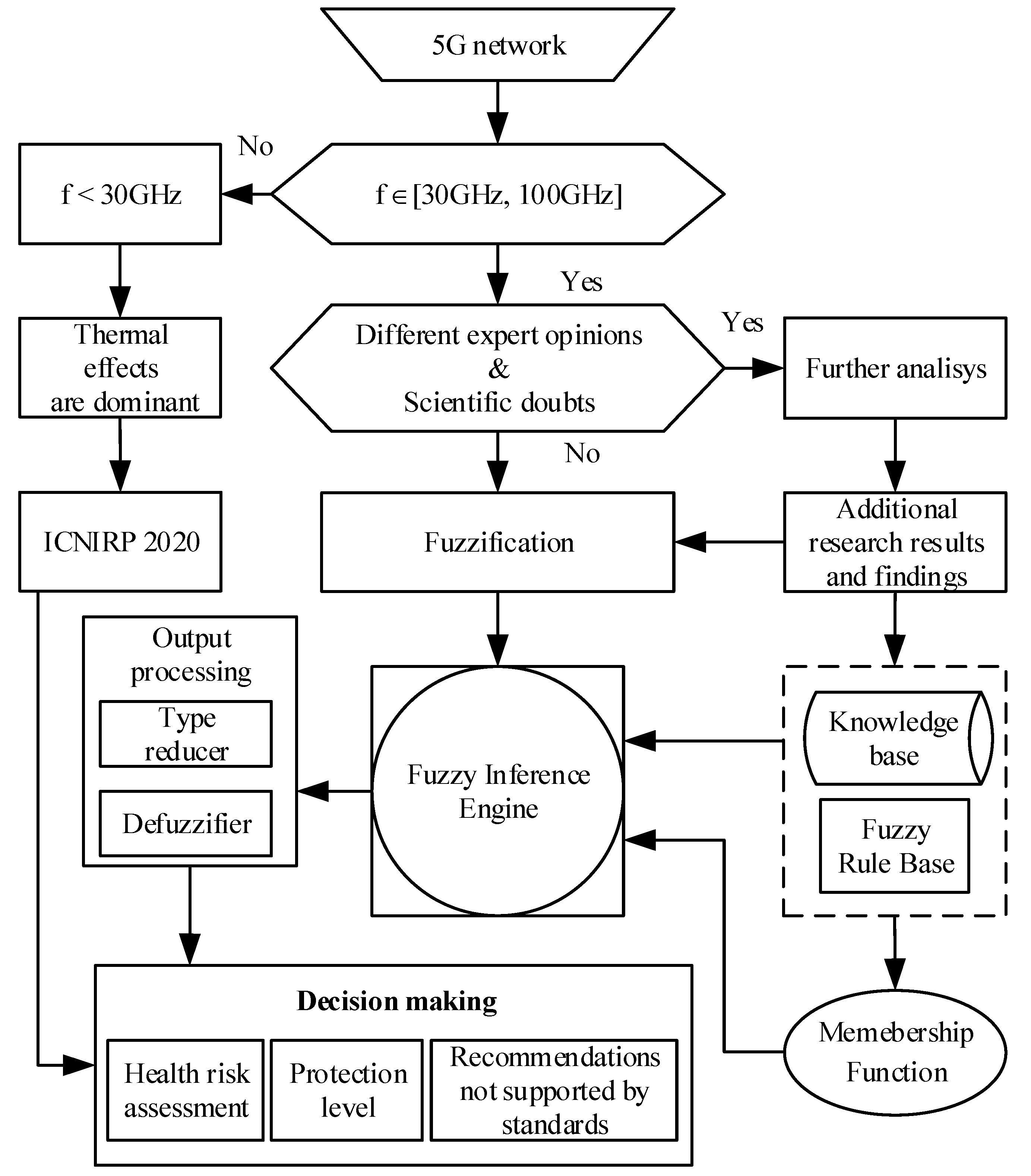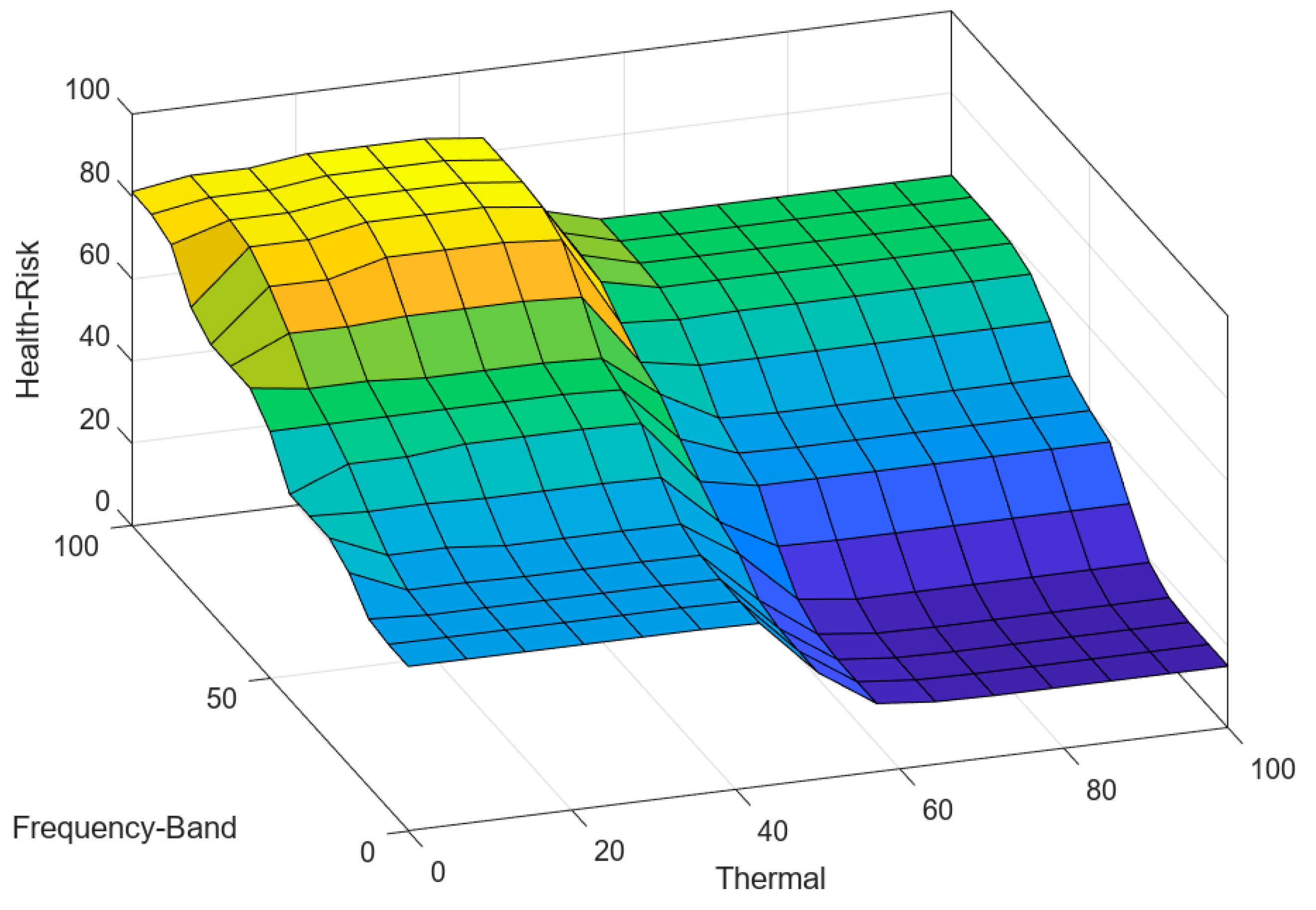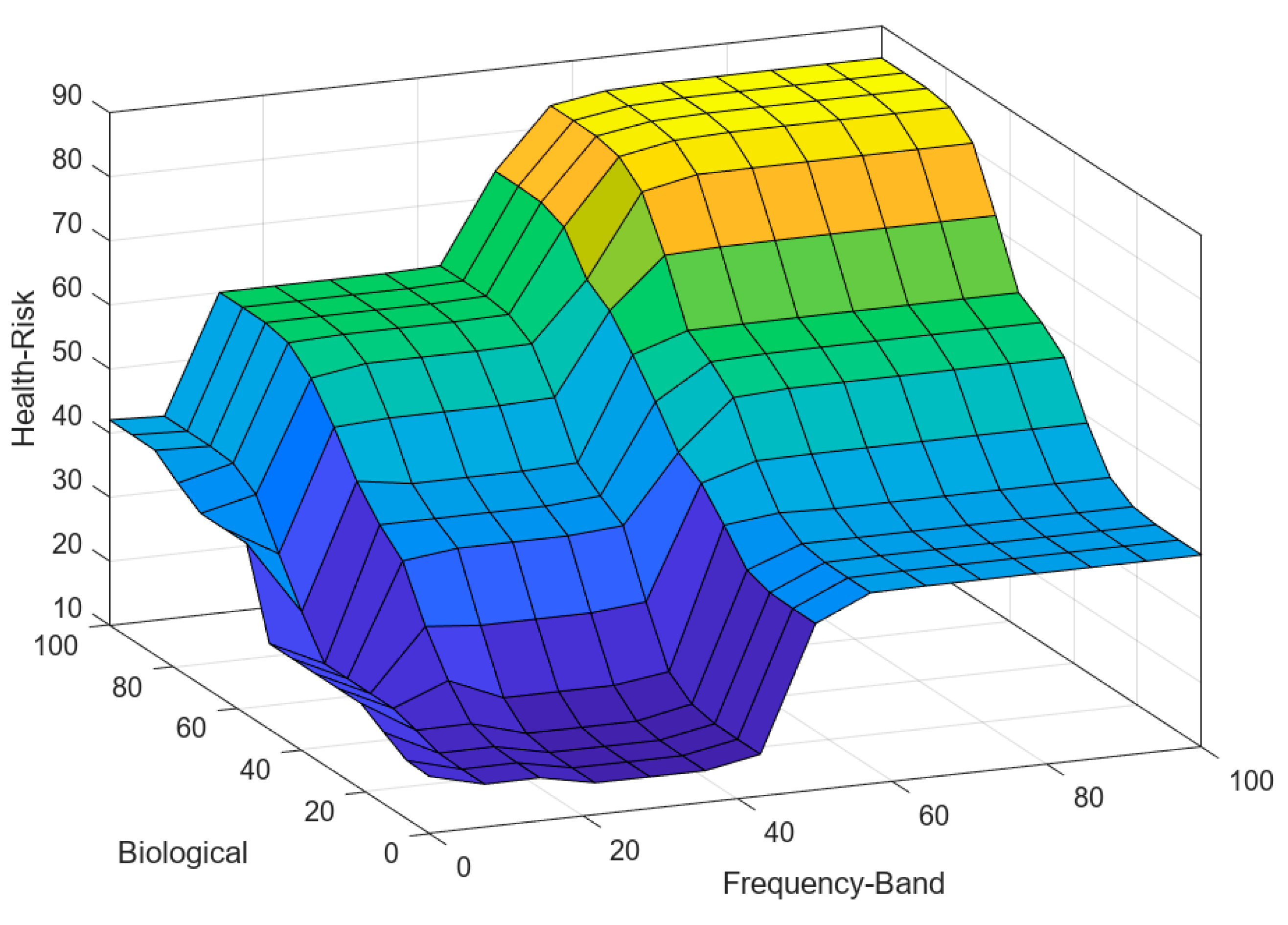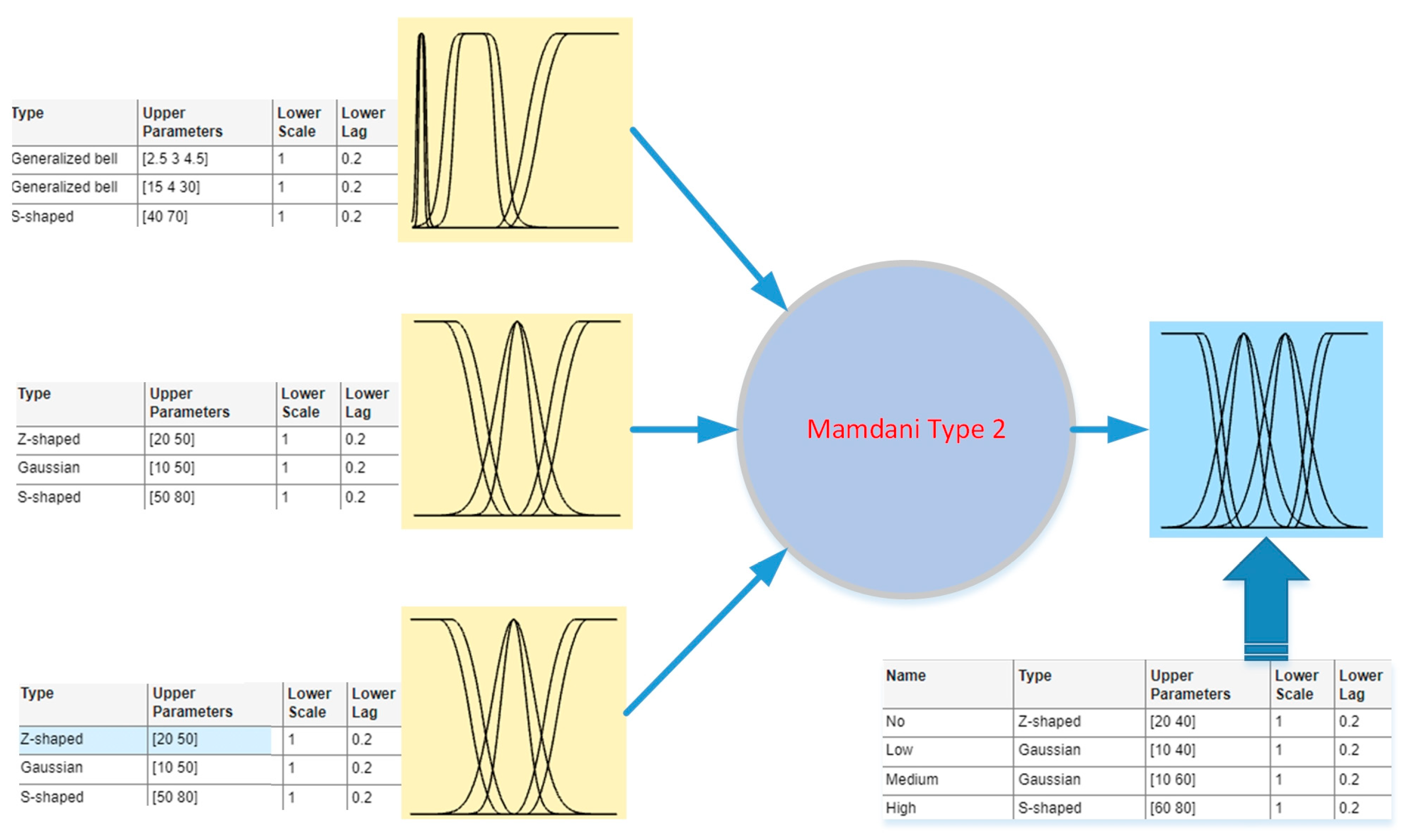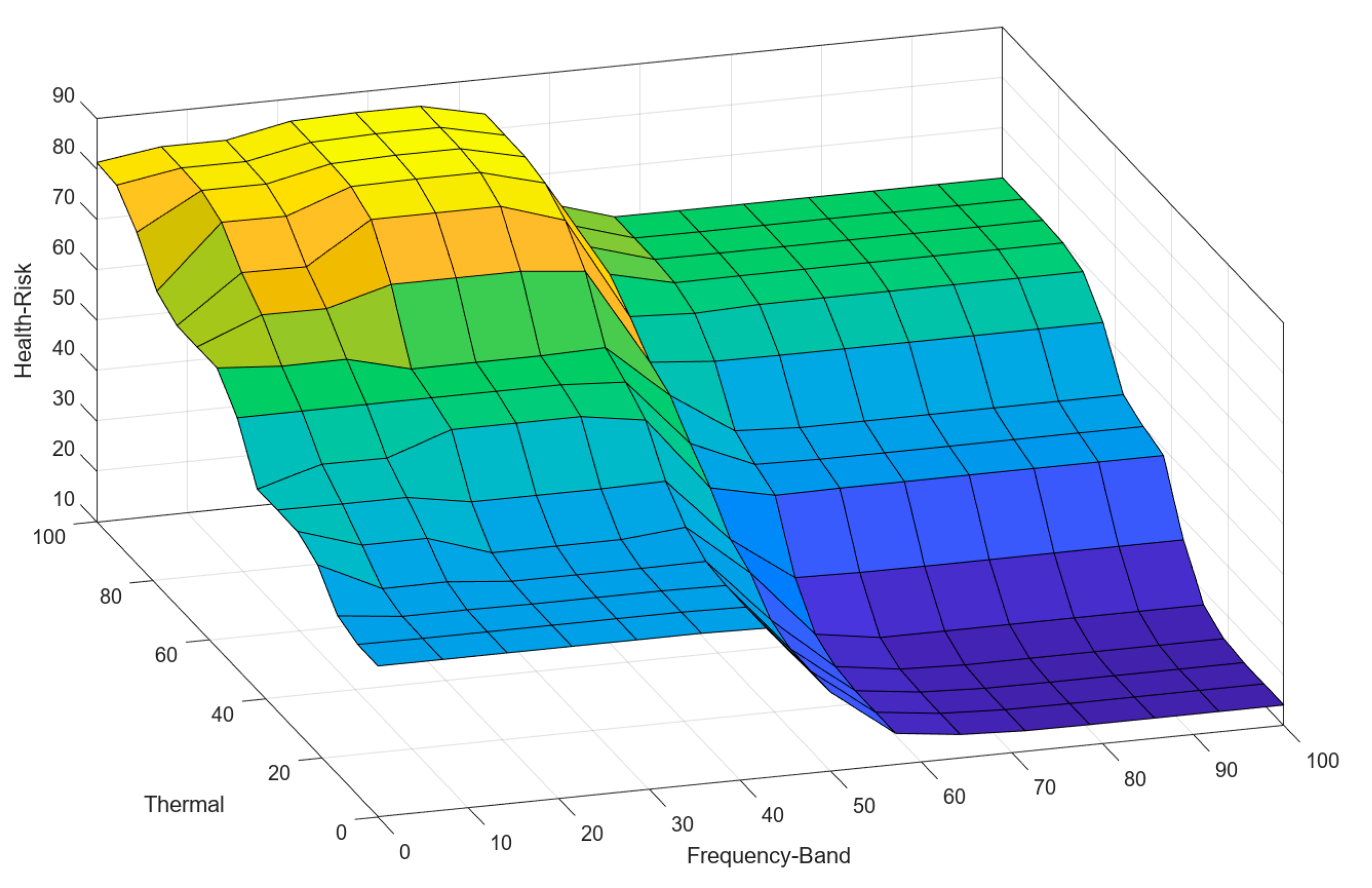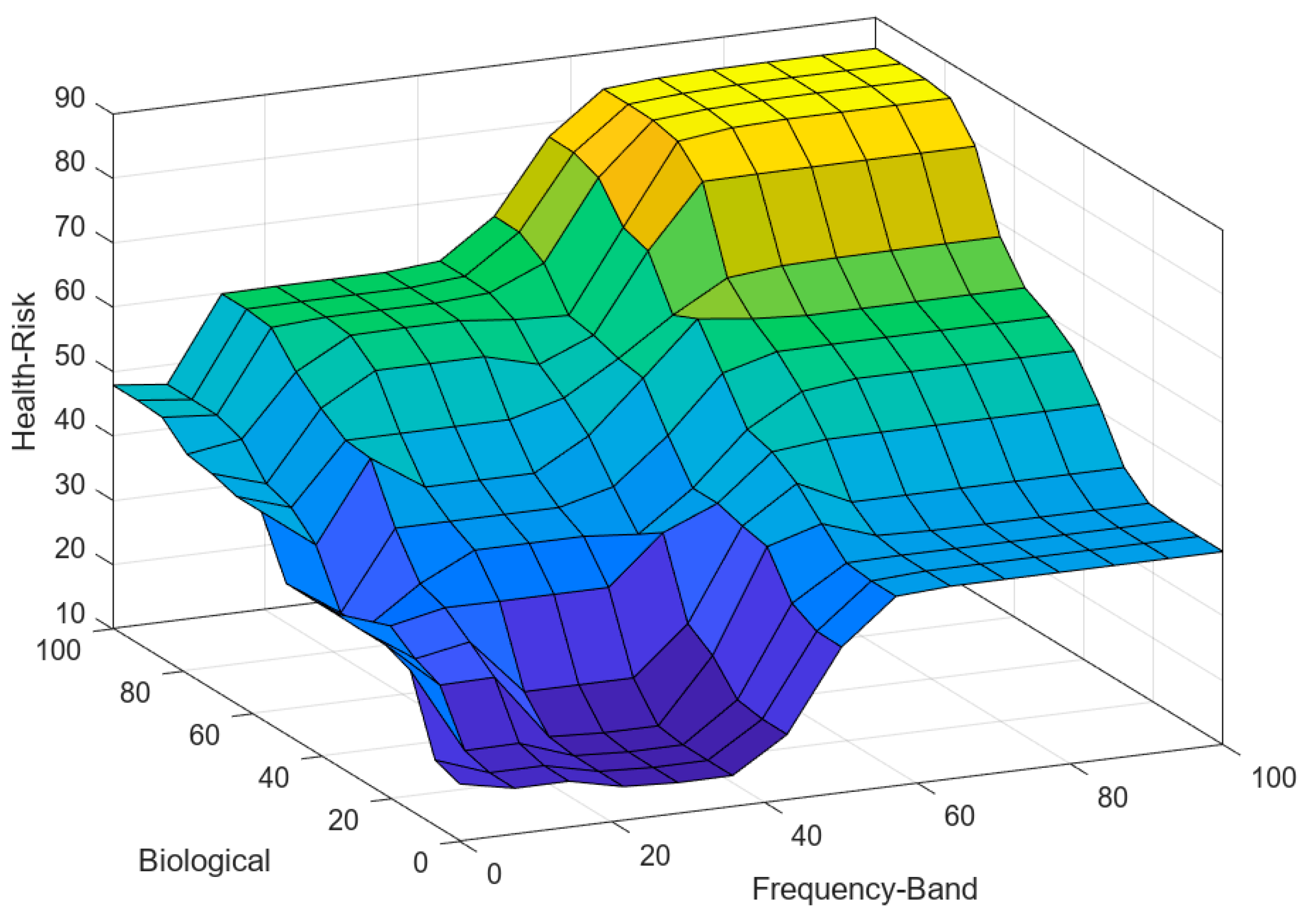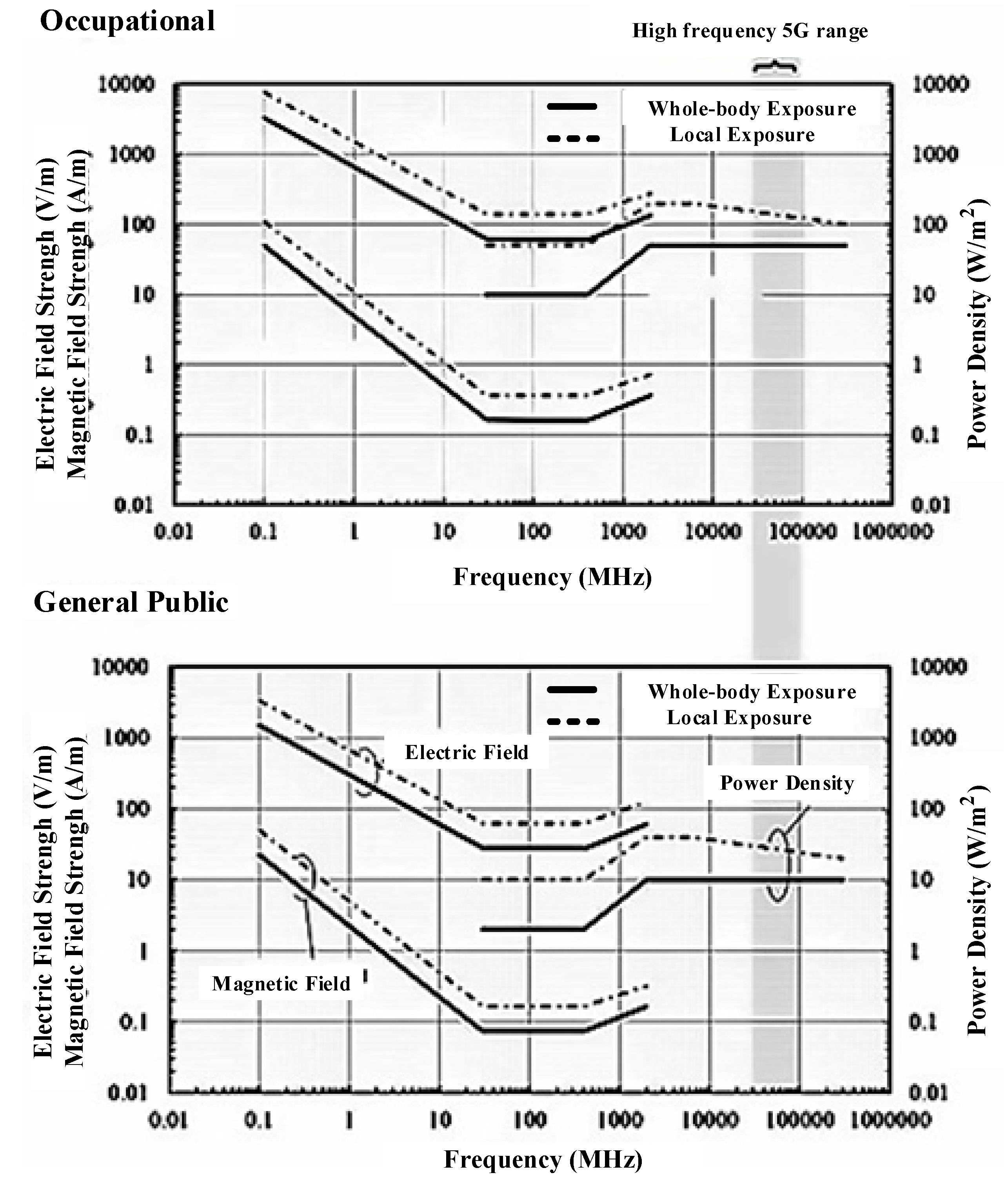1. Introduction
Due to the daily expansion of telecommunications systems (public mobile telephony, TV transmitters, GPS and GPSR systems, wireless Internet, etc.), there is growing concern among citizens and professional users, which consequently requires various studies on and testing of potentially adverse effects on humans.
The issue of electromagnetic radiation and health has implications for people and politics. Concerns about potential health risks associated with the 4G and 5G networks have led to public debates and discussions. Some individuals express concerns and take measures, such as exposure limiting or using protective gear. On the other hand, others are more confident in the safety of mobile networks based on the available scientific evidence and regulatory guidelines.
Public policy and regulations also play a role in addressing this issue. A few international organizations and regulatory bodies set standards and guidelines for radiation exposure to protect public health. These guidelines are often based on scientific research. However, the specific regulations can vary between countries and regions, leading to differences in permissible exposure limits.
Two key aspects have driven the research presented in this paper. The first relates to citizens’ concerns about many IoT wireless devices and their impact on health. The second aspect concerns professionals. They are often exposed to strong electromagnetic fields during the repair and maintenance of equipment.
Two international organizations, the ICNIRP (the International Commission on Non-Ionizing Radiation Protection) and the IARC (the International Agency for Research on Cancer), deal with this issue. Their objectives are to promote and disseminate knowledge about the health effects of non-ionizing radiation, to develop and revise guidelines for exposure limits and safety measures, and to collaborate with other organizations and stakeholders to ensure the implementation of its recommendations.
In this paper, a fuzzy decision-making algorithm for assessing the impact of electromagnetic fields (EMFs) on humans is proposed. Three starting points motivated the development of the algorithm. The first is the existing algorithm published by the authors [
1]. The second is the ICNIRP 2020 guidelines [
2]. The third regards the consequences of research presented in many epidemiological studies that indirectly indicate that thermal effects are not the only health consequences of EMF exposure. The IARC classifies agents that humans may be exposed to and deals with the condition analysis for radiation-induced cancer [
3].
In the first part of this paper, the authors state the differences and similarities between the ICNIRP guidelines editions (1998, 2010, and 2020) to modify and improve an existing algorithm [
1]. The second part deals with a brief analysis of several epidemiological studies that indicate the non-thermal effects of non-ionizing electromagnetic fields on human health (biological, neuropsychiatric, etc.). The third part deals with a brief analysis of 5G mobile networks, today’s Internet technologies, and the “smart” environment. The fourth part describes the decision-making process based on an algorithm whose output parameters are: recommended protection, health risk level, and the need for further research on adverse effects. The fuzzy model for assessing the impact of the 5G network is presented in the fifth part. In conclusion, the need for further research regarding confirming or rejecting concerns and dilemmas has been emphasized.
A fuzzy decision-making process is a type of decision-making technique that is used to solve complex and vague problems. This technique uses fuzzy logic, allowing for the representation of vague and imprecise information. The aim of this paper is to discuss the fuzzy decision-making process, its advantages, and practical applications.
The presented decision-making algorithm and fuzzy models have several common goals including the following: the assessment of EMFs’ impact on health according to valid recommendations and standards, the indication of unexplored adverse health effects, and the reduction of subjectivity in assessing EMFs’ impact on health. This paper represents a pioneering attempt to harmonize these three seemingly opposing aspects into a unique practically applicable methodology.
2. Overview of Open Questions, Guidelines, Recommendations, and Standards
In the last three decades, the number of sources of non-ionizing radiation has significantly increased. Most of them belong to radio frequency (RF) sources. A concern for human health has emerged because of radiation sources increasing in residential areas. Heat absorption due to exposure to RF-EMF is expressed in the SAR (specific absorption rate). The SAR is the rate of absorbed energy by a human body exposed to RF-EMF. Experiments on animals show the effects of their behavior due to radiation exposure with a SAR value of approximately 4 W/kg (1 °C tissue heating) or higher. The accepted SAR limit is 4 W/kg for the occupational population and 0.08 W/kg for the general population. With the emergence of new technologies in the urban environment, people are constantly exposed to low levels of RF radiation. These RF levels are unable to cause thermal effects. However, due to the continuing increase in the number of wireless devices, the issue of non-thermal effects is gaining importance. In 2011, the World Health Organization (WHO) and the IARC classified RF radiation as “group 2B”—possibly carcinogenic to humans [
4]. This classification means that the number of health studies is insufficient to draw reliable conclusions and that scientific research should continue. This classification is still valid today. So far, many studies have been conducted, but no study has provided a satisfactory methodology [
5].
2.1. A Brief Overview of ICNIRP (2020) versus ICNIRP (1998 and 2010)
The comprehensive approach involves consideration of frequency bands, types of adverse health effects, how to set limits, etc. The guidelines indicate permitted RF levels that should not be exceeded to ensure health protection. In this part of the paper, the authors provide a comparison between current and previous guidelines (ICNIRP 1998, 2010, and 2020) and a comprehensive analysis of several studies related to the assessment of non-thermal effects of RF-EMF. ICNIRP (2020) used the same approach as ICNIRP (1998). ICNIRP (1998) set sufficient guidelines for the thermal effects, and ICNIRP (2020) upgraded these guidelines, partially modified them, introduced new restrictions, and reduced or abolished some restrictions. There are two new restrictions for additional health protection in ICNIRP (2020). The first relates to new technologies that use RF above 6 GHz, such as the 5G mobile network. The second refers to short body exposures to RF (<6 min). The latest edition of ICNIRP took into account a broad frequency range from 100 kHz to 300 GHz. This will ensure that exposures from new technologies (5G mobile networks) do not lead to an excessive temperature rise deep in the body.
Intense bodily exposure to RF above 30 GHz can significantly increase the temperature of the local tissue. Accordingly, ICNIRP (2020) provides additional restrictions on energy absorption for the range from 400 MHz to 6 GHz and restrictions on absorbed energy densities for frequencies greater than 6 GHz. These restrictions should ensure that future new high-frequency technologies (5G and 6G mobile networks) do not cause an excessive temperature rise due to short exposure. ICNIRP (1998) provides reference levels for EMF in the far-field and near-field zones (
Figure 1), while ICNIRP (2020) provides reference levels for the near-field and far-field zones separately.
ICNIRP (2020) introduced several significant changes to protect against local radiation exposure higher than 6 GHz [
7]:
ICNIRP (1998–2010) used “incident power density” while ICNIRP (2020) uses “absorbed power density”;
Whereas the previous guideline averaged over a 20 cm2 region, the new one requires averaging over a 4 cm2 region (and even up to a 1 cm2 region); due to the emergence of new technologies (5G and 6G mobile networks), ICNIRP (2020) introduced a restriction of 1 cm2 for the calculation of highly focused beams above 30 GHz. Since the degree of focus increases with frequency, restrictions below 30 GHz have not been defined because the beams are not focused enough to cause harm;
ICNIRP (2020) does not recommend the averaging time reducing with increasing frequency, as it makes a poorer estimation than that predicted by the additional “short exposure limit”;
Instead of incident power density restrictions defined in ICNIRP (1998), ICNIRP (2020) provides absorbed power density restrictions for equivalent maximum body exposures above and below 6 GHz.
The advent of 5G technology has been a significant advancement in telecommunications. It offers faster Internet speeds, increased bandwidth, and lower latency. However, as 5G networks continue to expand, there are increasing concerns about the potential health risks associated with this technology. 5G technology relies on higher frequency radio waves than previous generations of wireless technology, which means that more energy is needed to transmit signals. This increased energy creates more electromagnetic radiation, and the proximity of the 5G antennas, which are expected to be placed much closer together, creates a higher risk of exposure to electromagnetic radiation.
ICNIRP (1998) included whole-body reference levels for electrical and magnetic fields and power densities above 10 GHz, while ICNIRP (2020) does not consider these fields for whole-body reference levels above 2 GHz.
Unlike ICNIRP (1998), ICNIRP (2020) does not provide contact-current reference levels but offers help by informing those responsible for occupational health and assisting them in a better understanding of hazards.
2.2. Health Effects from Non-Thermal Effects
In the last decade, many non-expert reports have caused numerous debates about the biological effects of RF-EMF. Following the scientific literature that deals with the adverse non-thermal effects of RF-EMF, we come across different findings and conclusions depending on the authors, the type of studies, the type of research, research financiers, etc. [
5]. Many review papers are based on available studies regarding RF’s impact on health in the range from 6 GHz to 100 GHz [
5,
6,
8,
9,
10,
11,
12,
13]. The state of the art of research can be classified into four key directions:
- 5.
Diseases caused by carcinogens;
- 6.
Effects on the nervous system and neurobehavioral disorders;
- 7.
Short-term symptoms: headache, fatigue, and dizziness;
- 8.
Other effects (reproductive and developmental effects).
The first two research directions refer to “in vivo” studies, “in vitro” studies, and epidemiological studies [
14]. The authors singled out several “objective” references in order to better explain the non-thermal effects of RF.
Many open questions can be found on the WHO website [
13]. What are the potential health risks of 5G? The answer is: “To date, and after much research performed, no adverse health effect has been causally linked with exposure to wireless technologies. Health-related conclusions are drawn from studies performed across the entire radio spectrum but, so far, only a few studies have been carried out at the frequencies to be used by 5G”. Millimeter wave and THz applications do not significantly affect the average exposure of humans. In these frequency ranges, low radiation power causes low penetration depth, i.e., the negative impact of radiation is mainly reflected on the surface tissues.
Many in vivo and in vitro studies (the various power densities from 0.02 to 450 mV/cm
2) have dealt with comprehensive analysis of cells, genes, proteins, etc. None of the relevant studies pointed to significant negative effects of radiation from the mentioned frequency range [
11,
15,
16].
However, as the number of studies grows, it must be noted that the paradigm slowly shifts from apriori non-acceptance to a new understanding and acceptance of scientific explanations and results of clinical studies. Another decade should pass so that conclusions can be drawn more reliably about the potential health hazards of high-frequency EMFs.
3. Pathway for Designing Methodology
There are differing opinions among experts and inconsistent recommendations and guidelines in many scientific and research areas. Because of that, a well-defined methodology can help in the proper selection of procedures and the development of a decision-making algorithm.
Many scientific studies, which have not been taken into account (justified or unjustified) in defining guidelines, recommendations, and standards, introduce great confusion in choosing a measurement methodology. It is necessary to analyze each measurement in accordance with valid recommendations and guidelines. Non-thermal effects, which have not been taken into account in creating the guidelines and recommendations, should also be considered. The paper should help engineers and researchers choose the right methodology or create a new one for assessing RFs’ impact on health. The benefit of the presented pathway principle is that a new parameter or procedure can be added anywhere in it without disturbing its sequence.
Figure 2 shows the pathway for designing methodology, which consists of the existing one given on the left side and a new part that, in addition to thermal effects, also takes into account non-thermal effects. The output parameters are the type of protection, health risk, and the proposal for further research. Protection and health risk are well-defined in the recommendations and guidelines. “Further research” refers to RF impacts that cannot be reliably defined in the existing recommendations and guidelines.
The pathway for designing methodology has been developed to help create new impact assessment and measurement methodologies that would take into account the high-frequency range (mm waves) of the 5G network but are also applicable to new technologies (the 6G network, etc.). The first step begins by identifying the RF sources in terms of the frequency range. For the lower frequency range up to 30 GHz, the next step defines the type of field that will be measured—electric, magnetic, or both—depending on the requirements and the technical capabilities of the measuring equipment. For higher frequencies (greater than 30 GHz), the following step should define the number of beamforming sources and their possible health impact. The distance from the RF source and the number of RF sources are important for RFs’ impact on health. The exposure time is also important for the assessment. The final step in the hierarchical sequence of activities is the description of the population exposed to RF radiation.
4. The Internet of Things (IoT) and the 5G Network—Knowledge and Doubt
Thanks to the spread of the Internet of Things (IoT), smart concepts are being involved in our environment. Today, we unconsciously belong to the mainstream IoT population using cell phones for playing video games, listening to music, looking for parking lots, making appointments, booking hotels, etc. The future living and working environment (
Figure 3) in Industry 5.0 will strictly depend on IoT management frameworks [
17]. Almost all emerging platforms (the Industrial Internet of Things—IIoT, te Military Internet of Things—MIoT, the Tackle Internet of Things—TioT, etc.) are powered by communication systems and computer networks (optical and wireless) [
18].
The merge of the IoT with 5G is seen as a powerful synergy that can unlock new possibilities and revolutionize various industries. It is important to understand the potential benefits of both technologies. Continuous research and security and protection measures are necessary to exploit these technologies addressing any concerns that may arise.
Higher telecommunication frequencies and shorter wavelengths should enable fast and reliable data exchange [
19]. The 5G network has emerged in response to the IoT requirements, enabling significantly higher data transfer rates and lower latency times. The frequency of 6 GHz represents the cut-off frequency between microwaves and millimeter waves. Millimeter wave technology is a critical component of 5G networks that promises to revolutionize the telecommunications industry. For RFs lower than 6 GHz, we can apply existing knowledge and findings, as well as recommendations and restrictions presented in ICNIRP (1998–2010), which have been proven by existing knowledge and research. However, the emergence of the 5G network presupposes the introduction of ten and more times higher frequencies than the 3G and 4G mobile networks. In addition to high expectations, the 5G network has certain limitations in terms of short distances (up to 300 m) and signal attenuation due to obstacles and atmospheric precipitation (
Figure 4). Another challenge associated with millimeter wave technology is interference. The millimeter wave frequency range is highly congested, and multiple devices operating in the same frequency range can interfere with each other, resulting in signal degradation.
The following solutions successfully overcome the limitation of 5G millimeter waves technology (
Figure 5):
Beamforming: Beamforming is a technique used to direct the transmission and reception of signals in a specific direction. It enables millimeter wave signals to be directed towards the user, reducing path loss and the improving signal strength.
Massive MIMO: Massive MIMO (multiple input multiple output) is another technique that can overcome the limitations of millimeter wave technology. It involves the use of multiple antennas at the base station and the user’s device, allowing multiple signals to be transmitted and received simultaneously, resulting in improved signal strength and reduced interference.
Hybrid Beamforming: Hybrid beamforming is a combination of beamforming and massive MIMO, allowing the antenna array to steer the beam in a specific direction while still maintaining the benefits of MIMO.
Obviously, the 5G millimeter range (
Figure 6) leads to new health requirements according to some researchers.
There are two frequency bands of the 5G mobile network:
According to two 5G bands, there are also two operating modes [
21]:
NSA mode (non-standalone mode). This operating mode is a combination of two technologies: NR (new radio) and LTE/LTE-A.
SA mode (standalone mode). This operating mode uses 5G NR technology for data exchange between mobile terminals and base stations.
The newest 6G telecommunication mobile system should be a cellular data network overcoming all of the shortcomings of the 5G and 4G mobile networks and supporting future AI devices and architectures.
5. Fuzzy Algorithm for the Assessment of 5G’s impact on Health
Researchers working on health and environmental issues often deal with vague concepts. The fuzzy algorithm (
Figure 7) is the logical link between the conceptual pathway (
Figure 2) and the fuzzy system (
Figure 8) used for fuzzy modeling. Since the 5G network covers several RF bands, the algorithm for assessing the impact of the 5G network on health (
Figure 7) consists of two parts. The first (left) part of the algorithm refers to RF frequencies up to 30 GHz and presents thermal effects analysis using ICNIRP 2020. The second (central and right) part of the algorithm refers to the analysis of the frequency range from 30 GHz to 100 GHz (the frequency range marked in gray in
Figure 1).
5.1. Fuzzy Logic
Fuzzy logic is a mathematical approach in which an object falls into a membership degree between completely true and false. Fuzzy logic has a wide range of applications, including control systems, decision-making, and pattern recognition. Fuzzy logic allows control systems to handle imprecise or uncertain data, which is particularly useful in situations where traditional control systems would be ineffective. One of the most common applications of fuzzy logic is in decision-making algorithms. Fuzzy logic can be used to model the decision-making process in a wide range of fields, including finance, engineering, and medicine. In multidisciplinary fields, fuzzy logic can be used to model the decision-making process that goes into designing complex systems. Fuzzy logic equations and fuzzy sets make use of linguistic variables to express uncertain or vague reasoning. They are expressed by membership functions that assign a degree of membership to a fuzzy set. Some commonly used fuzzy logic equations include:
Mamdani’s fuzzy inference method is used to map input variables to output variables using a set of fuzzy rules. The output is obtained by taking the weighted average of the rule outputs.
Takagi–Sugeno’s fuzzy inference method represents the output as a linear combination of the inputs. Its ability to handle complex systems with both continuous and discrete inputs makes it a popular choice for applications ranging from control systems to data analysis.
Fuzzy clustering is used to group items based on similarity using a fuzzy membership function.
Fuzzy decision trees are used to represent decision-making processes based on fuzzy rules.
Fuzzy neural networks are used to learn patterns and relationships in data using fuzzy logic.
Given the conflicting opinions on the benefits and negative impacts of the 5G network, this paper presents the fuzzy modeling of several scenarios based on RFs’ impact on health. The paper presents a few fuzzy models based on fuzzy decision theory and fuzzy logic systems (FLS) [
24]. There are a few types of fuzzy sets [
25,
26].
The measurement methodologies used for developing decision-making algorithms are affected by different uncertainties. Many of them could be processed using Fuzzy logic systems type-1 (FLS-T1) which has clear and precise membership functions. Application of FLS-T1 may be insufficient in the following cases: different expert opinions, the impact of the unknown EMF sources, spatial allocation of measurement points, the proximity influence of objects and obstacles, the weather conditions, etc. In such cases, fuzzy logic systems type-2 (FLS-T2) is used. FLS-T2 is characterized by a fuzzy membership function, whose values also belong to the interval [0, 1]. These functions are three-dimensional and include a footprint of uncertainty.
5.2. Fuzzy Logic System Type 1 (FLS-T1)
A fuzzy set
A on the universe of discourse
X is characterized by a membership function
μA:
X→[0, 1] (1). Fuzzy logic commonly uses several operations to manipulate fuzzy sets: union, intersection, and complement.
FLS type 1 is composed of the following components (
Figure 8): a KEG circle, a fuzzifier, fuzzy rules, an inference engine, and a defuzzifier [
27,
28].
Defuzzification is the process of converting the fuzzy output of a system into a crisp value. The KEG circle is a logical representation of the continuous interaction of expert opinions, ICNIRP guidelines, and knowledge base. This component plays a key role in health impact assessment.
There are two commonly used fuzzy logic systems (FLSs) depending on the way the crisp output is generated from the fuzzy inputs. Mamdani FLS (2) uses various techniques for computing fuzzy output, while Takagi–Sugeno–Kang FLS (3) uses weighted averages for computing crisp output. Both fuzzy logic systems are characterized by
if−then rules created depending on the set composed of expert opinions, ICNIRP guidelines, and knowledge base (the three circular iterative cycles in
Figure 8).
where
Fpn is antecedent fuzzy set type-1
Yn is consequent fuzzy set type-1
n is the number of rules (n = 1, ..., N)
p is the number of inputs (p = 1, ..., P).
The Mamdani defuzzification process is a little less efficient than the Takagi–Sugeno–Kang defuzzification process.
5.3. Fuzzy Logic Systems Type 2 and Type 3
Fuzzy logic systems type 1 can handle uncertainties with some limitations related to higher levels of uncertainty and complexity. To address these limitations, fuzzy logic systems type 2 (FLS-T2) was developed [
27,
28,
29]. FLS-T2 is widely used in control and decision-making algorithms and expert systems. FLS-T2 is more complex than FLS-T1. In FLS-T2, the membership functions themselves are fuzzy sets, and each membership function is defined by its upper and lower membership functions. Mamdani and Sugeno are the two main inference methods in FLS-T2.
The Mamdani inference method is widely used and involves a set of if–then rules. These rules consider the membership degree of inputs and compute the membership degree of the output. The Mamdani inference method uses a defuzzification process to convert the resulting fuzzy set back into a crisp output value. This inference method is suitable for applications with a high uncertainty degree.
The Sugeno inference method is another popular method for FLS-2. It uses a linear combination of input values to compute the output. This approach is faster and more accurate than the Mamdani method for certain applications, especially when the rule base is small. Sugeno inference is more suitable when the system output mainly depends on the input values.
When selecting between the Mamdani and Sugeno inference methods, the main factors to consider are the degree of dependency between inputs and outputs, the size of the rule base, and the speed and accuracy of the system response.
One significant advantage of FLS-T2 is that it can handle higher levels of uncertainty and complexity compared to FLS-T1. The other one is that it can incorporate more expert knowledge, making the system more intuitive and easier to operate. However, a big disadvantage of FLS-T2 is that it requires more computational resources and complex calculations.
Fuzzy logic systems type 3 (FLS-T3) is a relatively new area of research in the field of fuzzy logic. This system extends the classical type-1 and interval type-2 fuzzy sets to deal with more complex and uncertain environments. Until now, FLS-T3 only has a theoretical application, and the authors believe that the proposed algorithm would not be significantly improved by implementing it.
5.4. Fuzzy Modeling
Fuzzy modeling has been widely applied to approximate non-linear models by aggregating linear models with both numeric and linguistic inputs and non-linear weighting functions [
30,
31,
32,
33,
34]. Fuzzy modeling is a technique that uses fuzzy sets to model uncertain, imprecise, and/or vague information. Fuzzy modeling involves the following basic steps:
The first step in fuzzy modeling is to convert the inputs into fuzzy sets. This is acheived by assigning degrees of membership to each input based on their values.
- 2.
Rule base creation:
The rule base is a set of if–then rules that represent the relationship between the inputs and the outputs. The rules are created based on expert knowledge or by using data-driven techniques such as clustering.
- 3.
Inference:
Inference involves combining the rules to generate the output. This is achieved by using fuzzy logic operations such as and, or, and not.
- 4.
Defuzzification:
The final step in fuzzy modeling is to convert the fuzzy output into a crisp value. This is achieved by using techniques such as the centroid method or the maximum method.
In a fuzzy modeling process, the first step is to define the problem and identify the variables that are relevant to the decision. Next, these variables are described using fuzzy sets, which assign degrees of membership to each variable. After defining the fuzzy sets, the experts make a set of “if–then” rules for the variables in order to arrive at a decision. Finally, a decision is made by aggregating the results of the rules using a defuzzification process, which converts the fuzzy output into a crisp, numerical value.
6. Results and Discussion
The presented multiparameter fuzzy decision-making algorithm takes into account almost all key parameters according to ICNIRP guidelines. All of the data and frequency ranges, as well as the corresponding membership functions and fuzzy intervals of the observed parameters in the fuzzy model, were also made based on recommendations from ICNIRP guidelines. The presented algorithm was practically realized by software tools [
35]. The input parameters are the following: frequency, intensities of magnetic and electrical magnetic fields, SAR, penetration depth, social group (gender, age, and occupation), exposure time, etc.
Fuzzy rules are simple statements that specify a relationship between a system’s inputs and output. They consist of an antecedent (the if portion) and a consequent (the then portion) connected by the implication operator. The
if–then rules were created by using the ICNIRP guidelines (
Figure 1) and research papers [
6,
10,
11,
12]. Attention should be paid to the max and min values of 3D surfaces shown on the graphs that show which adverse health effects are dominant at the given frequencies.
6.1. Results—Fuzzy Model with the Mamdani Inference Method (Type 1)
The hands-on decision-making methodology was achieved using FLS-T1 and the
if−then rules. According to the frequency ranges (
Figure 1 and
Figure 6) and the fuzzy measurement algorithm (
Figure 7), a complex Mamdani fuzzy model is presented (
Table 1,
Figure 9 and
Figure 10).
Exposure time is one of the most important parameters, but we did not take it into account for frequencies higher than 30 GHz because there are no guidelines for adverse non-thermal effects at high RF frequencies. The results of future long-term research can be included in the presented model.
Fuzzy sets have also been applied to environmental science and policy. We consider the following four forms of fuzzy numbers (4)−(7):
- 2.
Generalized bell-shaped membership function:
- 3.
Z-shaped membership function:
- 4.
S-shaped membership function:
6.2. Results—Fuzzy Model with the Mamdani and Sugeno Inference Methods (Type 2)
FLS type 2 is composed of the following components (
Figure 8): a fuzzifier, fuzzy rules, an inference engine, a defuzzifier, and a type-reducer [
28]. Interval type 2 introduces uncertainty in both membership degrees and membership functions. It provides a more accurate representation of the complexities in decision-making processes where the level of uncertainty is high.
Figure 11 shows a fuzzy model based on FLS-T2 (with the same
if–then rules) with the aim of validating the developed algorithm. The results of fuzzy modeling are shown in
Figure 12 and
Figure 13.
6.3. Discussion
The use of FLS-T2, i.e., the use of membership functions whose values are also fuzzy numbers, slightly improves the accuracy of fuzzy modeling. The practical application of FLS-T2, with multiple inputs and outputs, is a complex mathematical problem. For this reason, the authors used FLS-T1 to develop a practically applicable algorithm. One of the practical advantages of the presented algorithm is its simple implementation in measuring devices. These devices could assess the impact of the measured radiation in the field in real time.
7. Conclusions and Future Work
Currently, valid recommendations and guidelines for assessing RFs’ impact on health do not fully cover all adverse health effects. In the ICNIRP 2020 guidelines, the analysis of thermal effects has been extended to the entire RF range, but it seems that this has not answered many open issues. Most doubts are related to various non-thermal effects that are a consequence of high-frequency RF radiation. A large number of scientific papers and expert opinions have appeared that indicate possible adverse health effects that are not only a consequence of tissue heating. This is especially emphasized for the frequency range above 30 GHz.
The rapid scientific and technical development with the application of the Internet of Things (IoT) strategies requires fast data transfer with a low latency time. The 5G network has emerged in response to these demands. This communication network involves a lot of transmitters with high operating frequencies, which has caused great concern for human health in urban areas. There is no reliable evidence that high-frequency RFs have adverse health effects, but it also cannot be said that such fears have no justification. The emergence of the 5G network has caused additional confusion.
The paper describes in detail the methodology and fuzzy decision algorithm for estimating RFs’ impact. The 3D graphs show the frequency bands in which some potentially adverse RF effects can occur. The paper represents a pioneering attempt to create a methodology for RF impact assessment with the aim of faster decision-making.
In implementing a hands-on fuzzy decision-making algorithm, an important role is played by the process that involves the expert’s role in analyzing knowledge bases and ICNIRP guidelines to define fuzzy numbers, choose inference methods, and create fuzzy rules. This is a three-step cyclical and iterative process affecting the final fuzzy model.
The main contribution of this work is a practically applicable methodology for quickly determining the impact of electromagnetic radiation on human health. This methodology should provide a good foundation for developing software solutions for portable devices that would give a rapid assessment of the impact of measured radiation based on in situ measurements.
The proposed algorithm should enable a straightforward assessment of the impact of electromagnetic radiation in field conditions where there is an unknown number of radiation sources.
The authors will focus future research on improving the fuzzy decision-making algorithm by considering, in addition to the ICNIRP guidelines, the results of medical studies analyzing the effects of wireless IoT devices in the urban environment.
